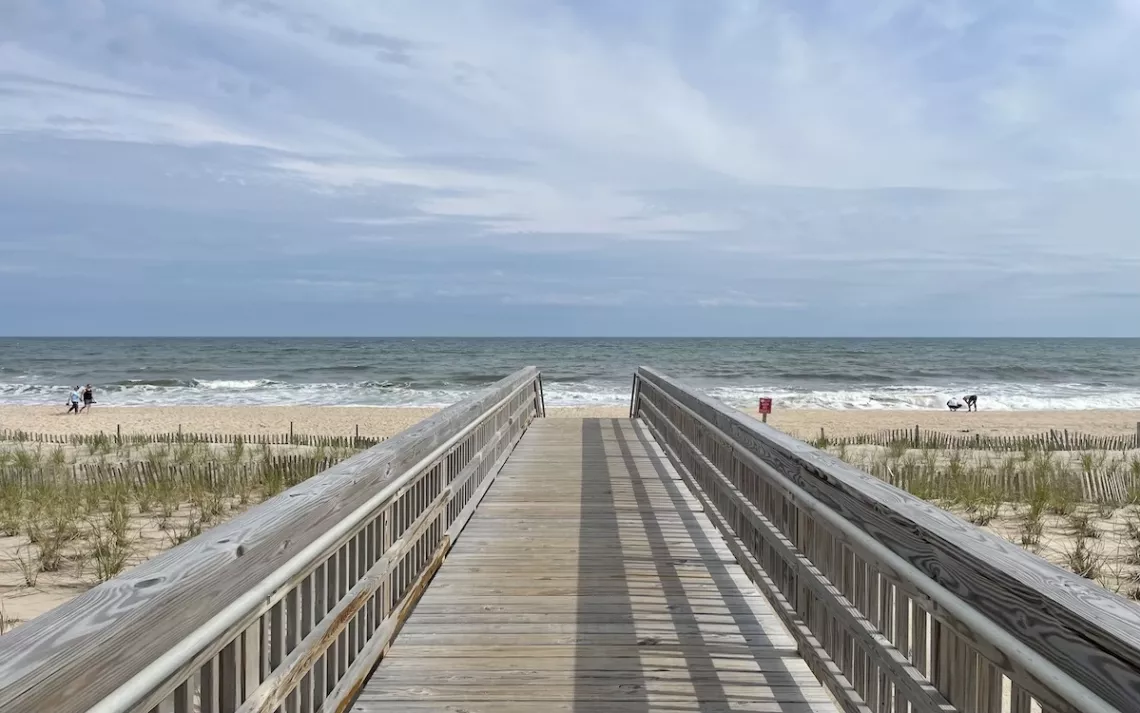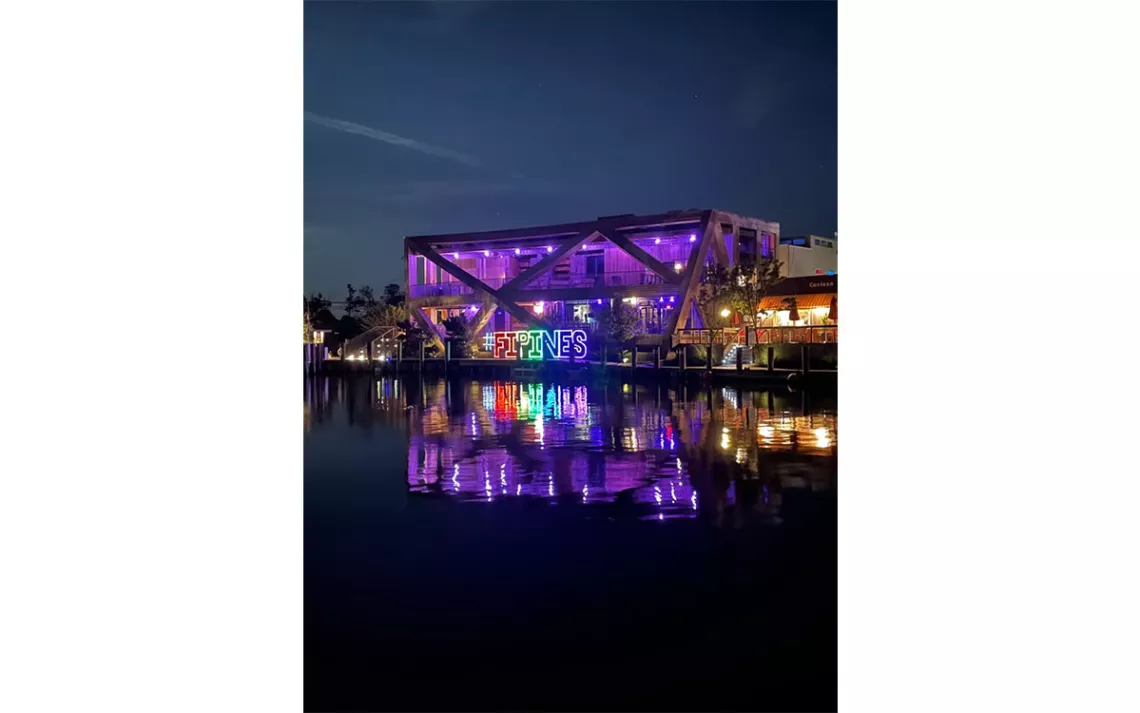Once Upon a Time There Was a Place Called Fire Island
Climate change is coming for the gay escape

Like so many famous gay getaways, Fire Island Pines is at the edge of the map, remote and relatively wild. Accessible only by boat or ferry, the small community of modernist wooden homes and charming boardwalks is nestled in a matrix of beach, dune, bog, and forest all scribbled atop the cold Atlantic. Though only 50 miles east of Manhattan, the narrow barrier island feels a world away from prying eyes. This has been the draw for generations of homosexuals, gays, and queers eager to escape a hostile world for a place where they could feel free with the assurance of privacy. On a summer weekend, boatloads of the LGBT confederation disembark at the Pines or nearby Cherry Grove to lounge, dance, stroll, love, and otherwise enjoy the rare place in which they are an overwhelming majority. The secluded nature of the landscape offers a tangible, if imperfect, taste of gay liberation.
“This place, which you have to take a train, another train, a bus and a ferry to get to, is not exactly somewhere one just shows up,” writes the poet Jack Parlett in his recently published history of Fire Island’s gay communities. “And this simple fact—of the island’s simultaneous proximity to and distance from the city, its requirement that you make the journey and cross the threshold into the unfamiliar—has long been … a crucial aspect of its allure.”
The cloistered coastal location that has made the island an iconic gay escape, however, has suddenly become a liability. Stephen Foster, a soon-to-be retired Manhattanite who has been coming to Fire Island Pines for 40 years, stood recently on the front of his little wooden cottage and pointed south toward the open ocean. In the autumn of 2012, Hurricane Sandy raged out of the Atlantic and punched through the island’s outer dunes, flooding homes, flattening trees, and stripping the beach of sediment. Foster’s home was barely spared—the flooding ended at the edge of his fence line.
“We were very lucky,” he told me during one of our several visits in recent years.
But the future looks unfriendly. Climate change is coming for this lovely island and other vacation havens—Provincetown, Key West—that figure prominently in gay history. According to a new report from the National Oceanic and Atmospheric Administration, the coastlines of the Northeastern United States will likely see sea level rise between roughly 2 and 7 feet by the end of this century, though these estimates may turn out to be conservative. Beyond 2100, the potential collapse of Antarctic ice sheets due to unmitigated global warming could make for even more extreme outcomes. Much of Fire Island, though not all, is low lying.
Already, the federal government, which manages large tracts of Fire Island as a national seashore, is grappling with the crisis. The Army Corps of Engineers, for instance, is currently at work on a $1.7 billion project that will help replenish the island’s beaches, restore its dunes, and raise homes onto stilts to spare them (at least temporarily) from the coming storms, erosion, flooding, and more. Such projects are a sign of how urgent the problem is, but in the long run they may only delay the inevitable—the eventual loss of Fire Island as a place fit for human habitation.

Photo by Galo Trujillo
*
After a recent weekend of the usual routine—days on the beautiful beach with friends, nights at parties full of beautiful men—I walked down the boardwalk to the harbor at the heart of the Pines to meet Jordan Raphael. A wildlife biologist with the National Park Service who has worked on the island for 15 years, he invited me aboard his dune buggy and we went zipping westward down the beach. We passed gaggles of gays and lesbians lounging in the sun; we passed Cherry Grove, the island’s original queer enclave; we passed an untouched stretch of sand where imperiled shorebirds raise their babies. Finally we arrived at our destination: the sunken forest. A large grove of holly trees hidden behind a barricade of towering dunes, this maritime forest is a globally rare gem. There are only two of its kind left in the world.
As we walked under the dense canopy of 300-year-old trees, Raphael explained the situation: the forest, he told me, is vanishing. He pointed to a low-lying patch of ground in the middle of the island. The trees there were all dead, killed off by saltwater intrusions into the island’s fresh groundwater, the result of sea level rise. Then he took me to the island’s north shore, which faces the bay that separates it from the Long Island mainland. Here, vast swaths of forest have been wiped out by erosion, storm surges and, again, sea level rise. The forest is being converted into high salt marsh. For Raphael, this is an omen—a sign of the vast transformation underway here due to the impacts of climate change.
“It is all eroding, it is eroding at a super rapid rate, at a scary rate, at a rate that is actually depressing,” Raphael told me. “We have lost 30 to 40 percent [of the sunken forest] over the last 50 years.”
In the long run, Raphael believes that stronger storms will punch holes in the narrow island’s dune defenses while sea level rise erodes the shore and salt water seeps up through the ground into the island’s interior. Together, these impacts will likely transform Fire Island into a string of smaller islands, narrow and vulnerable. When I asked if he believes that humans will eventually have to abandon this place, he said: “I think so.”
“People are going to hang on as long as they can, and I can’t blame them for that. Fire Island is a magnificent place, but I think at some point it is going to be a pearl of islands,” he said. “Maybe not within our lifetime, but the generation after that is going to have to figure out what to do.”
Raphael’s colleague at the Park Service, Michael Bilecki, put it to me another way: “The long-term scenario for Fire Island,” he said, “is that in a hundred years or so a lot of it could be under water.”
The gay communities on Fire Island are, of course, aware of these threats. The vast beach replenishment project that the Army Corps of Engineers is undertaking has literally reshaped the landscape here—entire homes have been moved, reconfigured, lifted on stilts, or demolished. The beach has been widened, dunes have been restored, grass has been planted and fences installed to hold in the sand. Meanwhile, the Pines homeowner’s association is starting to organize around the coming troubles. It launched a new climate task force this year, following in the footsteps of Cherry Grove, which started its own climate change committee last fall. According to Ken Wong, who leads the Grove’s committee, the ultimate goal is simple and stark: “We want to preserve the Pines and the Grove beyond 2050.” That’s what is at stake.
In more pessimistic moments, I tend to doubt that anything can preserve the island for long. Indeed, in defending the human property and infrastructure of Fire Island, people may actually be contributing to its woes. Barrier islands are remarkably resilient—their complex sand and sediment cycles allow them to move and grow in reaction to changing sea and storm conditions. But buildings, bulkheads, piers, ports, and the like tend to disrupt these cycles, blocking the natural movement of sediment, contributing to erosion and debilitating a barrier island’s dynamic ability to evolve in response to the forces of wind and water. As so often happens where humans are concerned, there seems to be a tragic irony at work: Our love for Fire Island adds to its trouble.
Then again, the value of all that human infrastructure, all those boardwalks and beachside buildings, is real too. There is too much meaning here to let the Pines and the Grove go without a fight. After spending several summers in the Pines with the first real group of gay friends in my life, after falling for my boyfriend in this place, I feel that at a personal level. So too do people like Stephen Foster, who has experienced both joy and tragedy in this place. He started coming out to Fire Island Pines as a young gay man in the post-Stonewall era of sexual freedom. He was here too when the plague came. During one of our visits, while standing as usual on his front porch, he pointed north to a house he rented with friends back in the 80s.
“After a few years,” he said, “everybody except me and one other had passed away from AIDS.”
Beyond the personal significance of this place for so many, history here goes deep. Fire Island was where the great gay poet Frank O’Hara met his early end in a tragic accident on the beach. It is the setting for some of the most important works of gay literature. It has been a destination for legendary gay artists, activists, and more. James Baldwin, W.H. Auden, Patricia Highsmith, Frank Kameny, Larry Kramer, Robert Mapplethorpe, Edmund White are just a sampling of the figures who have strolled these shores. And the tradition of Fire Island as muse continues to this day—a major comedy about the island from Bowen Yang and Joel Kim Booster just hit Hulu.
The island’s cultural and historical importance, as well as its ecological majesty, mean that there are many thousands of people who are trying to keep this place afloat. I want them to succeed—I want future generations to see this place and experience the excitement and beauty of its warm summer days and wild nights. The odds, though, seem awfully long. As one island resident recently told me: “I hope one day we are not saying, ‘Once upon a time there was a place called Fire Island.’”
 The Magazine of The Sierra Club
The Magazine of The Sierra Club



